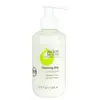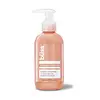What's inside
What's inside
 Key Ingredients
Key Ingredients

 Benefits
Benefits

 Concerns
Concerns

 Ingredients Side-by-side
Ingredients Side-by-side

Vitis Vinifera
MaskingAloe Barbadensis Leaf Juice
Skin ConditioningGlycerin
HumectantCetearyl Alcohol
EmollientCaprylic/Capric Triglyceride
MaskingPrunus Amygdalus Dulcis Oil
Skin ConditioningCarthamus Tinctorius Seed Oil
MaskingRubus Idaeus Juice
AstringentHelianthus Annuus Seed Oil
EmollientSesamum Indicum Seed Oil
EmollientHydrolyzed Linseed Extract
Skin ConditioningCetearyl Glucoside
EmulsifyingGluconolactone
Skin ConditioningCalcium Gluconate
HumectantSodium Benzoate
MaskingPotassium Sorbate
PreservativePotassium Hydroxide
BufferingSodium Citrate
BufferingCitric Acid
BufferingCalendula Officinalis Extract
Skin ConditioningChamomilla Recutita Extract
Skin ConditioningTilia Cordata Extract
RefreshingPanthenol
Skin ConditioningAscorbic Acid
AntioxidantTocopherol
AntioxidantAllantoin
Skin ConditioningXanthan Gum
EmulsifyingCitrus Sinensis Peel Oil Expressed
PerfumingOlibanum
MaskingVitis Vinifera, Aloe Barbadensis Leaf Juice, Glycerin, Cetearyl Alcohol, Caprylic/Capric Triglyceride, Prunus Amygdalus Dulcis Oil, Carthamus Tinctorius Seed Oil, Rubus Idaeus Juice, Helianthus Annuus Seed Oil, Sesamum Indicum Seed Oil, Hydrolyzed Linseed Extract, Cetearyl Glucoside, Gluconolactone, Calcium Gluconate, Sodium Benzoate, Potassium Sorbate, Potassium Hydroxide, Sodium Citrate, Citric Acid, Calendula Officinalis Extract, Chamomilla Recutita Extract, Tilia Cordata Extract, Panthenol, Ascorbic Acid, Tocopherol, Allantoin, Xanthan Gum, Citrus Sinensis Peel Oil Expressed, Olibanum
Water
Skin ConditioningGlycerin
HumectantSodium Lauroyl Methyl Isethionate
CleansingCocamidopropyl Betaine
CleansingSalix Nigra Bark Extract
Skin ProtectingPropanediol
SolventCocamidopropyl Hydroxysultaine
CleansingRosa Damascena Flower Water
MaskingAcrylates Copolymer
Sodium Lauroyl Sarcosinate
CleansingPanthenol
Skin ConditioningRosa Damascena Extract
MaskingColloidal Gold
AntimicrobialRhododendron Ferrugineum Leaf Cell Culture Extract
Skin ConditioningPhalaenopsis Amabilis Extract
HumectantCaesalpinia Sappan Bark Extract
Skin ConditioningCitrus Aurantium Bergamia Fruit Oil
MaskingPelargonium Graveolens Flower Oil
MaskingHydrolyzed Silk
HumectantLactic Acid
BufferingIsomalt
HumectantLecithin
EmollientAnhydroxylitol
HumectantCaprylic/Capric Triglyceride
MaskingXylityl Sesquicaprylate
AntimicrobialPEG-150 Pentaerythrityl Tetrastearate
EmulsifyingPEG-6 Caprylic/Capric Glycerides
EmulsifyingCaprylyl/Capryl Glucoside
CleansingCalcium Aluminum Borosilicate
Silica
AbrasiveTin Oxide
AbrasiveMica
Cosmetic ColorantTetrasodium Glutamate Diacetate
Pentylene Glycol
Skin ConditioningPhenoxyethanol
PreservativeEthylhexylglycerin
Skin ConditioningPotassium Sorbate
PreservativeSodium Benzoate
MaskingSodium Hydroxide
BufferingCitric Acid
BufferingLimonene
PerfumingLinalool
PerfumingCitronellol
PerfumingCI 77891
Cosmetic ColorantCI 77491
Cosmetic ColorantWater, Glycerin, Sodium Lauroyl Methyl Isethionate, Cocamidopropyl Betaine, Salix Nigra Bark Extract, Propanediol, Cocamidopropyl Hydroxysultaine, Rosa Damascena Flower Water, Acrylates Copolymer, Sodium Lauroyl Sarcosinate, Panthenol, Rosa Damascena Extract, Colloidal Gold, Rhododendron Ferrugineum Leaf Cell Culture Extract, Phalaenopsis Amabilis Extract, Caesalpinia Sappan Bark Extract, Citrus Aurantium Bergamia Fruit Oil, Pelargonium Graveolens Flower Oil, Hydrolyzed Silk, Lactic Acid, Isomalt, Lecithin, Anhydroxylitol, Caprylic/Capric Triglyceride, Xylityl Sesquicaprylate, PEG-150 Pentaerythrityl Tetrastearate, PEG-6 Caprylic/Capric Glycerides, Caprylyl/Capryl Glucoside, Calcium Aluminum Borosilicate, Silica, Tin Oxide, Mica, Tetrasodium Glutamate Diacetate, Pentylene Glycol, Phenoxyethanol, Ethylhexylglycerin, Potassium Sorbate, Sodium Benzoate, Sodium Hydroxide, Citric Acid, Limonene, Linalool, Citronellol, CI 77891, CI 77491
Ingredients Explained
These ingredients are found in both products.
Ingredients higher up in an ingredient list are typically present in a larger amount.
This ingredient is an emollient, solvent, and texture enhancer. It is considered a skin-softener by helping the skin prevent moisture loss.
It helps thicken a product's formula and makes it easier to spread by dissolving clumping compounds.
Caprylic Triglyceride is made by combining glycerin with coconut oil, forming a clear liquid.
While there is an assumption Caprylic Triglyceride can clog pores due to it being derived from coconut oil, there is no research supporting this.
Learn more about Caprylic/Capric TriglycerideCitric Acid is an alpha hydroxy acid (AHA) naturally found in citrus fruits like oranges, lemons, and limes.
Like other AHAs, citric acid can exfoliate skin by breaking down the bonds that hold dead skin cells together. This helps reveal smoother and brighter skin underneath.
However, this exfoliating effect only happens at high concentrations (20%) which can be hard to find in cosmetic products.
Due to this, citric acid is usually included in small amounts as a pH adjuster. This helps keep products slightly more acidic and compatible with skin's natural pH.
In skincare formulas, citric acid can:
While it can provide some skin benefits, research shows lactic acid and glycolic acid are generally more effective and less irritating exfoliants.
Most citric acid used in skincare today is made by fermenting sugars (usually from molasses). This synthetic version is identical to the natural citrus form but easier to stabilize and use in formulations.
Read more about some other popular AHA's here:
Learn more about Citric AcidGlycerin is already naturally found in your skin. It helps moisturize and protect your skin.
A study from 2016 found glycerin to be more effective as a humectant than AHAs and hyaluronic acid.
As a humectant, it helps the skin stay hydrated by pulling moisture to your skin. The low molecular weight of glycerin allows it to pull moisture into the deeper layers of your skin.
Hydrated skin improves your skin barrier; Your skin barrier helps protect against irritants and bacteria.
Glycerin has also been found to have antimicrobial and antiviral properties. Due to these properties, glycerin is often used in wound and burn treatments.
In cosmetics, glycerin is usually derived from plants such as soybean or palm. However, it can also be sourced from animals, such as tallow or animal fat.
This ingredient is organic, colorless, odorless, and non-toxic.
Glycerin is the name for this ingredient in American English. British English uses Glycerol/Glycerine.
Learn more about GlycerinPanthenol is a common ingredient that helps hydrate and soothe the skin. It is found naturally in our skin and hair.
There are two forms of panthenol: D and L.
D-panthenol is also known as dexpanthenol. Most cosmetics use dexpanthenol or a mixture of D and L-panthenol.
Panthenol is famous due to its ability to go deeper into the skin's layers. Using this ingredient has numerous pros (and no cons):
Like hyaluronic acid, panthenol is a humectant. Humectants are able to bind and hold large amounts of water to keep skin hydrated.
This ingredient works well for wound healing. It works by increasing tissue in the wound and helps close open wounds.
Once oxidized, panthenol converts to pantothenic acid. Panthothenic acid is found in all living cells.
This ingredient is also referred to as pro-vitamin B5.
Learn more about PanthenolPotassium Sorbate is a preservative used to prevent yeast and mold in products. It is commonly found in both cosmetic and food products.
This ingredient comes from potassium salt derived from sorbic acid. Sorbic acid is a natural antibiotic and effective against fungus.
Both potassium sorbate and sorbic acid can be found in baked goods, cheeses, dried meats, dried fruit, ice cream, pickles, wine, yogurt, and more.
You'll often find this ingredient used with other preservatives.
Learn more about Potassium SorbateSodium Benzoate is a preservative. It's used in both cosmetic and food products to inhibit the growth of mold and bacteria. It is typically produced synthetically.
Both the US FDA and EU Health Committee have approved the use of sodium benzoate. In the US, levels of 0.1% (of the total product) are allowed.
Sodium benzoate works as a preservative by inhibiting the growth of bacteria inside of cells. It prevents the cell from fermenting a type of sugar using an enzyme called phosphofructokinase.
It is the salt of benzoic acid. Foods containing sodium benzoate include soda, salad dressings, condiments, fruit juices, wines, and snack foods.
Studies for using ascorbic acid and sodium benzoate in cosmetics are lacking, especially in skincare routines with multiple steps.
We always recommend speaking with a professional, such as a dermatologist, if you have any concerns.
Learn more about Sodium Benzoate